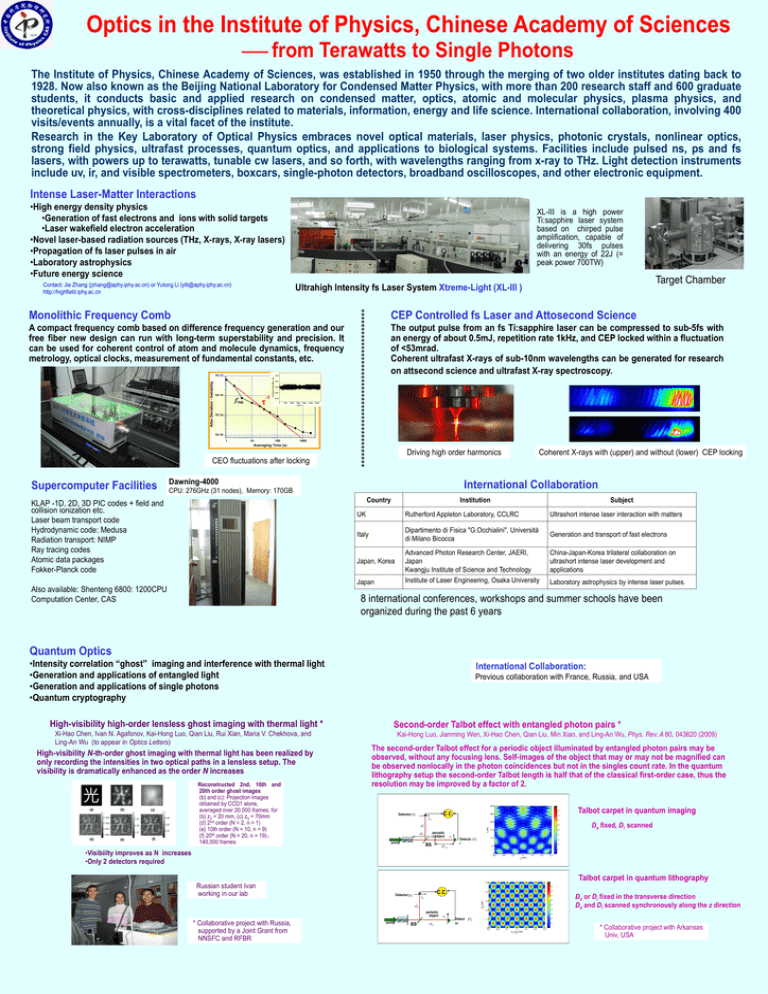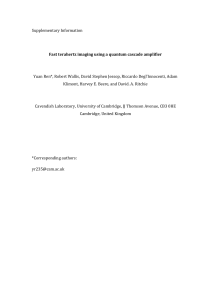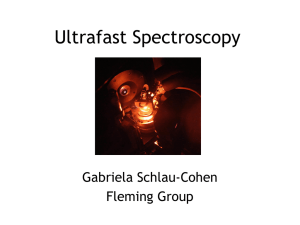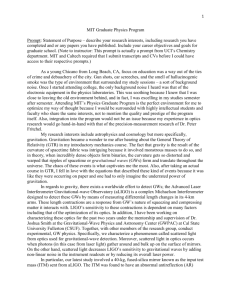PowerPoint 演示文稿
advertisement

Optics in the Institute of Physics, Chinese Academy of Sciences from Terawatts to Single Photons The Institute of Physics, Chinese Academy of Sciences, was established in 1950 through the merging of two older institutes dating back to 1928. Now also known as the Beijing National Laboratory for Condensed Matter Physics, with more than 200 research staff and 600 graduate students, it conducts basic and applied research on condensed matter, optics, atomic and molecular physics, plasma physics, and theoretical physics, with cross-disciplines related to materials, information, energy and life science. International collaboration, involving 400 visits/events annually, is a vital facet of the institute. Research in the Key Laboratory of Optical Physics embraces novel optical materials, laser physics, photonic crystals, nonlinear optics, strong field physics, ultrafast processes, quantum optics, and applications to biological systems. Facilities include pulsed ns, ps and fs lasers, with powers up to terawatts, tunable cw lasers, and so forth, with wavelengths ranging from x-ray to THz. Light detection instruments include uv, ir, and visible spectrometers, boxcars, single-photon detectors, broadband oscilloscopes, and other electronic equipment. Intense Laser-Matter Interactions •High energy density physics •Generation of fast electrons and ions with solid targets •Laser wakefield electron acceleration •Novel laser-based radiation sources (THz, X-rays, X-ray lasers) •Propagation of fs laser pulses in air •Laboratory astrophysics •Future energy science XL-III is a high power Ti:sapphire laser system based on chirped pulse amplification, capable of delivering 30fs pulses with an energy of 22J (= peak power 700TW) Contact: Jie Zhang (jzhang@aphy.iphy.ac.cn) or Yutong Li (ytli@aphy.iphy.ac.cn) http://highfield.iphy.ac.cn Ultrahigh Intensity fs Laser System Xtreme-Light (XL-III ) A compact frequency comb based on difference frequency generation and our free fiber new design can run with long-term superstability and precision. It can be used for coherent control of atom and molecule dynamics, frequency metrology, optical clocks, measurement of fundamental constants, etc. 0.002 1E-14 frep -1 Frequency Deviation / Hz Allan Deviation - Instability 1E-13 0.001 0.000 -0.001 -0.002 0 5000 10000 15000 20000 25000 30000 Time / s 1E-15 1E-16 10 100 1000 Averaging Time (s) CEO fluctuations after locking Supercomputer Facilities CEP Controlled fs Laser and Attosecond Science ******************************************* Monolithic Frequency Comb 1 Target Chamber The output pulse from an fs Ti:sapphire laser can be compressed to sub-5fs with an energy of about 0.5mJ, repetition rate 1kHz, and CEP locked within a fluctuation of <53mrad. Coherent ultrafast X-rays of sub-10nm wavelengths can be generated for research on attsecond science and ultrafast X-ray spectroscopy. Driving high order harmonics Dawning-4000 International Collaboration CPU: 276GHz (31 nodes), Memory: 170GB Country KLAP -1D, 2D, 3D PIC codes + field and collision ionization etc. Laser beam transport code Hydrodynamic code: Medusa Radiation transport: NIMP Ray tracing codes Atomic data packages Fokker-Planck code Institution Subject UK Rutherford Appleton Laboratory, CCLRC Ultrashort intense laser interaction with matters Italy Dipartimento di Fisica "G.Occhialini", Università di Milano Bicocca Generation and transport of fast electrons Advanced Photon Research Center, JAERI, Japan Kwangju Institute of Science and Technology Institute of Laser Engineering, Osaka University Japan, Korea Japan Also available: Shenteng 6800: 1200CPU Computation Center, CAS Coherent X-rays with (upper) and without (lower) CEP locking China-Japan-Korea trilateral collaboration on ultrashort intense laser development and applications Laboratory astrophysics by intense laser pulses. 8 international conferences, workshops and summer schools have been organized during the past 6 years Quantum Optics •Intensity correlation “ghost” imaging and interference with thermal light •Generation and applications of entangled light •Generation and applications of single photons •Quantum cryptography High-visibility high-order lensless ghost imaging with thermal light * Xi-Hao Chen, Ivan N. Agafonov, Kai-Hong Luo, Qian Liu, Rui Xian, Maria V. Chekhova, and Ling-An Wu (to appear in Optics Letters) High-visibility N-th-order ghost imaging with thermal light has been realized by only recording the intensities in two optical paths in a lensless setup. The visibility is dramatically enhanced as the order N increases Reconstructed 2nd, 10th and 20th order ghost images (b) and (c): Projection images obtained by CCD1 alone, averaged over 20,000 frames, for (b) z3 = 20 mm, (c) z3 = 70mm (d) 2nd order (N = 2, n = 1) (e) 10th order (N = 10, n = 9) (f) 20th order (N = 20, n = 19), 140,000 frames (a) (b) International Collaboration: Previous collaboration with France, Russia, and USA Second-order Talbot effect with entangled photon pairs * Kai-Hong Luo, Jianming Wen, Xi-Hao Chen, Qian Liu, Min Xiao, and Ling-An Wu, Phys. Rev. A 80, 043820 (2009) The second-order Talbot effect for a periodic object illuminated by entangled photon pairs may be observed, without any focusing lens. Self-images of the object that may or may not be magnified can be observed nonlocally in the photon coincidences but not in the singles count rate. In the quantum lithography setup the second-order Talbot length is half that of the classical first-order case, thus the resolution may be improved by a factor of 2. Talbot carpet in quantum imaging C.C. Detector Di x2 Ds fixed, Di scanned di periodic object d s1 pump SPDC BS ds2 x1 Detecto Ds r •Visibiilty improves as N increases •Only 2 detectors required Talbot carpet in quantum lithography Russian student Ivan working in our lab C.C. DetectorDi Ds or Di fixed in the transverse direction Ds and Di scanned synchronously along the z direction x2 d0 periodic object * Collaborative project with Russia, supported by a Joint Grant from NNSFC and RFBR pump SPDC BS d0 x1 Detect Ds or * Collaborative project with Arkansas Univ, USA











